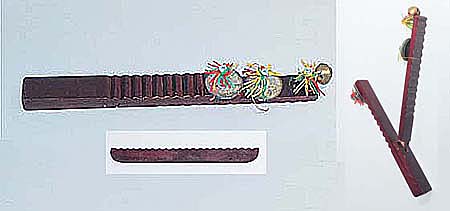
Owner: HWMC
Catalog#: 2AS-IDST-16
Clappers
Vietnam ‘Sênh Tiền’ (Clapper/Rasp/Jingle)
Vietnam
Vietnamese
Mahogany, metal, yarn
Mid 20th century
Slapstick length: 10.75 in, Width: 1 in, Depth: .8 in (wood), 1.75 in (including screws); Rasp length: 9.75 in, Width: 1 in, Depth: .25 in
Idiophones – Struck Idiophones – Clappers
The sênh tiền (sinh tien) is a Vietnamese musical instrument that consists of a clapper, rasp, and jingle. This sênh tiền is made from three pieces of wood, old Chinese coins and a small brass bell. It is played among the Muong (Mwai) people, an ethnic group native to northern Vietnam. According to Randy Raine-Reusch, it was used in the Vietnamese Nguyen Court from the early 19th century and is still used today in numerous other musical styles.
The main body of this sênh tiền consists of two mahogany wooden slats. Both have cut corrugated grooves on the backside of each slat, with a pinned wooden hinge joining them together at the end of the shorter slat. Two woodscrews decorated with red, yellow, and green yarn and a set of double metal disc coins are attached, one on each slat. A third woodscrew with yellow, red, and green thread is attached to a strung brass bell. The separate rasp stick has corrugated grooves on one side and is smooth and curved on the opposite side. When played, one hand holds the main body with the index finger resting on the corrugated part of the bottom (short) slat, controlling the slaps (strikes) with the upper slat. The striker is held in the opposite hand and can either hit the main body, or scrape the grooves on the bottom or top slats to produce a variety of rhythmic patterns.
Resource: “Play the World: The 101 World Instrument Primer,” Randy Raine-Reusch, MelBay Publications, Inc., 2008.
